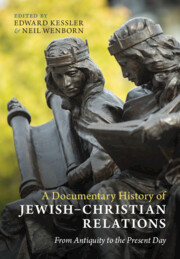Book contents
- A Documentary History of Jewish–Christian Relations
- A Documentary History of Jewish–Christian Relations
- Copyright page
- Dedication
- Contents
- Contributors
- Editors’ Preface
- Acknowledgements
- Abbreviations of Rabbinic Literature and Scripture
- Documents
- Introduction
- Part I To 900 ce
- Part II 900 to 1800
- Part III 1800 to the Present Day
- Index of Documents and Sources
- Index of Names and Subjects
2 - Eastern and Western Writings up to the Ninth Century
from Part I - To 900 ce
Published online by Cambridge University Press: 03 October 2024
- A Documentary History of Jewish–Christian Relations
- A Documentary History of Jewish–Christian Relations
- Copyright page
- Dedication
- Contents
- Contributors
- Editors’ Preface
- Acknowledgements
- Abbreviations of Rabbinic Literature and Scripture
- Documents
- Introduction
- Part I To 900 ce
- Part II 900 to 1800
- Part III 1800 to the Present Day
- Index of Documents and Sources
- Index of Names and Subjects
Summary
This chapter shows the Jewish context of the New Testament and discusses the implications of the fact that while these writings are primarily Jewish, they have become Christian scripture. The documents highlight continuities and discontinuities between Judaism and Christianity, including themes found throughout the Documentary History, such as covenant and the identity of the people of Israel.
Keywords
- Type
- Chapter
- Information
- A Documentary History of Jewish–Christian RelationsFrom Antiquity to the Present Day, pp. 65 - 112Publisher: Cambridge University PressPrint publication year: 2024

